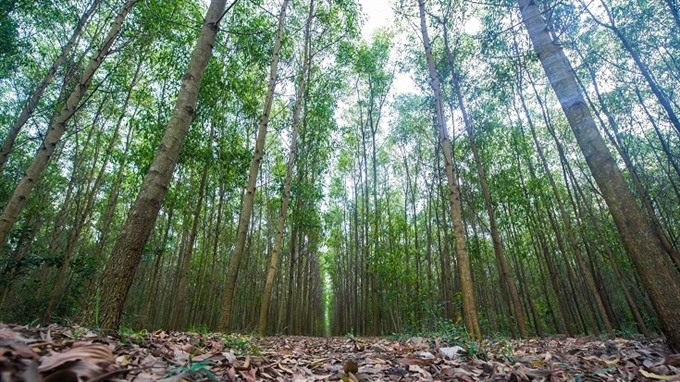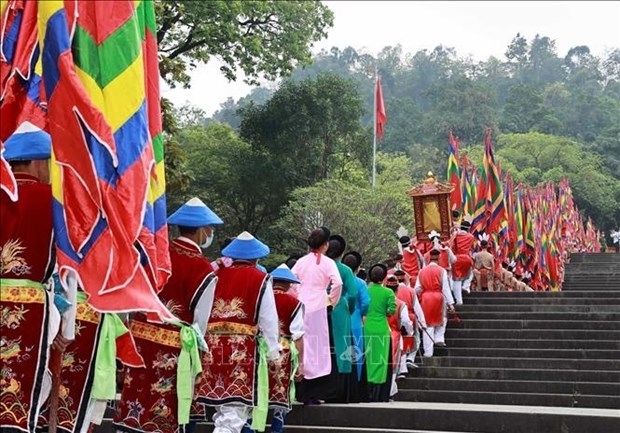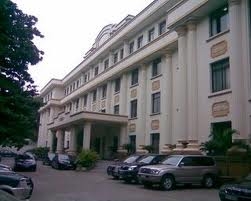Sustainable forestry development program in a period of 2021 - 2025
Thursday, November 30,2023
AsemconnectVietnam - Develop forestry to truly become a modern, effective, efficient and competitive economic and technical sector, linked in a chain from forest development, forest protection, forest use to processing and trade in forest products; manage, protect, develop and sustainably use forest areas and land areas planned for forestry development
I. Objectives
1. General objectives
Develop forestry to truly become a modern, effective, efficient and competitive economic and technical sector, linked in a chain from forest development, forest protection, forest use to processing and trade in forest products; manage, protect, develop and sustainably use forest areas and land areas planned for forestry development; promote the potential, role and effects of forests to make an increasingly important contribution to socio-economic development; contributing to creating jobs, increasing income for people associated with protecting the ecological environment, preserving biodiversity of forest ecosystems, enhancing the ability to adapt to climate change, and minimizing impacts negative impacts caused by natural disasters, reducing greenhouse gas emissions, absorbing and storing carbon from forests, contributing to implementing Vietnam's commitments at the 26th Conference of Parties to the United Nations Framework Convention on climate change (COP26); contribute to protecting national defense and security.
2. Specific objectives
a) Protection and sustainable development of the entire existing forest area and newly created forest area in the period 2021 - 2025; contributing to stably maintaining the national forest coverage rate of about 42%; Continue to improve productivity and forest quality, meet the requirements of providing raw materials for production and consumption, protect and protect the environment, preserve biodiversity, and minimize negative impacts caused by natural disasters, enhancing the ability to adapt to climate change.
b) The growth rate of forestry production value reaches 5.0 - 5.5%/year. The export value of wood and non-wood forest products will reach about 20 billion USD by 2025, of which the export value of non-wood forest products will reach over 1.5 billion USD, increasing the proportion of deep processing and export of wood products and forest products with high added value.
c) Contribute to creating jobs and increasing income for people participating in forest protection and development activities. By 2025, income from planted production forests will increase on average about 1.5 times/unit area compared to 2020.
II. Scope, object, location and implementation time
1. Scope of Program implementation
The program is implemented nationwide, excluding:
- Activities under the National Target Programs for the period 2021 - 2025;
- Activities on developing forestry varieties according to Decision No. 703/QD-TTg dated May 28, 2020 of the Prime Minister approving the Program for developing research and seed production to serve the restructuring of the agricultural sector industry in the period 2021 - 2030;
- Programs and projects using official development assistance (ODA) and concessional loans from foreign donors, non-refundable aid sources that are not part of official development assistance from agencies , foreign organizations and individuals for Vietnam.
Forest protection and development activities in communes with difficult socio-economic conditions (regions II and III) in ethnic minority and mountainous areas under the National Target Program for Economic Development - society in ethnic minority and mountainous areas in the period 2021 - 2030, ensuring funding for implementation according to Resolution No. 120/2020/QH14 dated June 29, 2020 of the XIV National Assembly, to achieve the goals of Sustainable forestry development program for the period 2021 - 2025.
The above programs and projects are integrated to achieve the goals and tasks of the forestry sector.
2. Program implementation location: Nationwide.
3. Program implementation period: 2021 - 2025.
4. Program Owner: Ministry of Agriculture and Rural Development.
III. Key tasks
1. Regarding forest protection and biodiversity conservation of forest ecosystems
a) Well protect existing forest areas, especially natural forest areas; ensure a reasonable structure of 3 types of forests (special-use forests, protection forests, production forests); Effectively implement forest fire prevention and fighting.
100% of the forest area of special-use forest management boards, protection forest management boards and forest owners who are organizations of all economic sectors are effectively managed.
b) Effectively implement biodiversity conservation in special-use forests (national parks, nature reserves, species and habitat conservation areas...), and forests with high biodiversity.
2. Develop forests and improve productivity and quality of forests
a) For natural forests
Zoning to promote natural regeneration, zoning to promote natural regeneration with additional planting: an average of 100 thousand hectares/year, of which, mainly is zoning for transitional regeneration. Effectively implement silvicultural technical measures to nurture and enrich natural forests.
b) For planted forests
Planting concentrated forests on 230 thousand hectares/year, including: 4 thousand - 6 thousand hectares/year of protection forests, special-use forests, and coastal forests; about 225 thousand hectares/year of production forests (new planting 10 thousand hectares/year, replanting 215 thousand hectares/year), of which 30% of the area is planted with large, intensive timber forests.
Improve productivity and quality of planted forests; By 2025, the productivity of planted forests will reach an average of 20 m3/ha/year, the output of wood from domestic planted forests (wood from concentrated planted forests, scattered trees...), will meet about 80%, raw materials for production and processing.
c) Development of non-timber forest products: By 2025, the area of non-timber forest products will reach about 700 - 800 thousand hectares.
3. Sustainable forest management and forest certification for planted production forests
Organize effective management and exploitation of 100% of planted production forest areas, of which, by 2025, the forest area with sustainable forest management certificates will reach 500 thousand hectares.
IV. Priority content
1. Protect forests, prevent forest fires and develop special-use forests, protection forests, and coastal forests
a) Invest in the protection and sustainable development of areas of special-use forests, protection forests, and production forests that are existing natural forests, effectively implement programs and projects on biodiversity conservation forest ecosystems.
b) Invest in restoring and developing the protection forest system, especially watershed protection forests and coastal protection forests with investment rates determined according to the provisions of law and economic-technical norms set by the Government, authorized state agency to issue and specific conditions of the planting location.
c) Invest in protection, fire prevention and fighting equipment; Build infrastructure for forest protection, conservation, and development of forests at Forest Management Boards, ensuring adequate conditions for regular activities and forest protection patrols. Support the construction of forestry roads for units and localities with concentrated raw material areas, areas with difficult socio-economic conditions.
d) Organize the implementation of projects: investigation, assessment and monitoring of forest resources nationwide; Build, complete and operate an automatic forest monitoring system to detect forest fires; Applying advanced and modern technology in management, investigation, inventory and monitoring of forest resource developments.
2. Develop forestry tree varieties and plant large timber forests
a) Investing and supporting investment in developing forestry tree varieties and non-timber forest products, including: selecting, creating, transferring, producing and supplying seeds in an industrial and modern direction, creating new breakthroughs in productivity, product quality.
b) Support for planting large timber forests and converting small timber forests to large timber forests.
3. Development of non-timber forest products
Support the development of non-timber forest products according to the strengths of each locality, region and region; Building raw material areas with concentrated non-timber forest products associated with the development of processing industry, creating specific products for each region and suitable to market needs.
4. Develop forest product processing industry
Support investment and development of the wood and forest product processing industry according to mechanisms and policies to encourage businesses to invest in rural areas and relevant legal regulations.
V. About the Program's projects
1. Projects using state budget capital
a) Projects using public investment capital
- Projects using central budget: Implemented according to the medium-term public investment plan with state budget capital for the period 2021 - 2025 in Decision No. 1535/QD-TTg dated September 15, 2021 of the Prime Minister , other projects in the medium-term public investment plan 2021 - 2025 according to the provisions of law on public investment.
- Project using local budget: Implemented according to the local medium-term public investment plan for the period 2021 - 2025.
b) Activities and projects using non-business capital
The Ministry of Agriculture and Rural Development, ministries, branches and localities develop, approve and deploy activities and projects to implement the Program's contents and solutions associated with strategies, plans and projects, key forestry sectors are directly managed by units after the Program is approved, ensuring the Program's objectives, in accordance with the provisions of the State Budget Law and relevant legal provisions.
2. Projects using other legal capital sources
Support projects; Investment projects of organizations and individuals for forest protection and development, forestry development projects are implemented in accordance with current laws for each capital source.
BECAUSE. Estimated total capital and principles for allocating central budget capital to implement the Program
1. Total estimated capital to implement the Program: 78,585 billion VND, of which:
a) State budget: 13,682 billion VND, including:
- Central budget: 7,484 billion VND, including: development investment capital of 3,084 billion VND, economic capital of 4,400 billion VND;
- Local budget: 6,198 billion VND.
b) Other legal capital sources: 64,903 billion VND.
2. Principles for allocating central budget capital to support Program implementation
a) The allocation and assignment of central budget capital to implement the Program to ministries, central branches and localities must ensure compliance with the principles, criteria and norms of central budget capital allocation according to the Resolution No. 973/2020/UBTVQH14 dated July 8, 2020 of the National Assembly Standing Committee stipulating the principles, criteria and norms for allocating public investment capital from the state budget in the period 2021 - 2025; Decision No. 26/2020/QD-TTg dated September 14, 2020 of the Prime Minister and relevant legal provisions.
b) Central budget sources for implementing the Program are balanced and arranged in the medium-term public investment plan for the period 2021 - 2025, annual budget estimates according to each capital source:
- Arrange in annual state budget expenditure estimates of ministries and central branches to carry out assigned tasks of the Program.
- The central budget is an economic source to support localities in implementing the Program according to the principle: supplementing part of the funding for localities that cannot balance their own budgets and other localities according to the provisions of law to implement contents and tasks of the Program, with priority given to supporting localities with large forest areas, difficult budget revenue sources, border areas, islands and coastal areas.
The central budget to support localities in implementing the Program is determined on the basis of tasks and support levels according to current mechanisms and policies.
The allocation of funds (business capital) prioritizes activities: management and protection of special-use forests, protection forests, and natural production forests; Implement schemes and projects approved by competent authorities; Activities on forest investigation and statistics, forest inventory, monitoring of forest resource developments, evaluation and monitoring activities of the Program, and specific activities to implement the Program approved by competent authorities according to provisions of law.
VII. Solution
1. Improve mechanisms and policies
a) Continue to effectively implement current investment mechanisms and policies according to the provisions of law.
b) Review, evaluate, adjust and supplement current mechanisms and policies or develop new policies to implement the Program; Organize and monitor the implementation of forestry laws.
2. Propagate and disseminate policies and laws
Strengthen communication about the role and economic, social, environmental value and role of forests in reducing greenhouse gas emissions, absorbing and storing carbon, responding to climate change, and protecting national defense. forest protection and security; Raising awareness about sustainable forest development, large timber plantations with high productivity and quality, and using forest products of legal origin; Disseminate forestry laws to people, raise social awareness about forest management and protection, forest fire prevention and fighting, and prevent illegal cutting and destruction of forests.
3. Forest and forestry land planning management
a) Develop and implement the National Forestry Plan for the period 2021 - 2030, with a vision to 2050, ensuring compliance with the national master plan, national land use planning, and development strategy. forestry development, national strategy on biodiversity; ensure sustainable forest management; Exploitation and use of forests associated with conservation of natural resources, enhancing the economic value of forests and cultural and historical values; protect the environment, respond to climate change and improve people's livelihoods.
b) Strictly control the conversion of forests to other purposes, resolutely handle violations of the law on illegal buying, selling and transfer of forests and forestry land.
c) Continue to allocate and lease forests to households, individuals, communities and economic sectors according to the provisions of law to ensure that the entire forest area has real, equal forest owners, while improving efficiency in forest management and forest development.
d) Encourage forms of joint venture and cooperation in afforestation, forest development, and formation of concentrated raw material areas to serve the production and processing of wood and forest products.
4. Consolidate and innovate production organization
a) Continue to reorganize, innovate and improve operational efficiency of state forestry companies; Encourage the formation of joint stock companies, forestry cooperatives and other forms of cooperation between forest owners in developing production forests to form concentrated raw material areas in accordance with national forestry planning and socio-economic development plans of each locality, region; Promote the effective implementation of forestry sector restructuring.
b) Organize production according to chain links from afforestation, forest exploitation, product processing and consumption to improve production efficiency and competitiveness; Encourage the formation of large, reputable and branded enterprises in the production and processing of wood and forest products associated with raw material areas.
c) Encourage the formation of associations to support the development of production forests, non-timber forest products...; improve capacity for forest owners and businesses in domestic and international production and trade organizations; Build an information system to classify wood processing and export enterprises.
d) Continue to research and replicate cooperation models in forestry; promote and create favorable conditions for farmers and households to contribute to businesses to organize commodity forestry production; exploit and take advantage of tropical forestry, build and develop large-scale production areas.
5. Science, technology and forestry extension
a) Develop and implement programs, projects, research projects, selection and creation to improve forest tree varieties and non-timber forest products (native trees, imported trees with high productivity and quality); techniques of intensive forestry and planting of large timber forests; Applying high technology and advanced technology in the stages of afforestation, exploitation and processing of wood and forest products to improve productivity and quality; Biodiversity conservation effectively exploits benefits from genetic resources. Focus on implementing research programs and developing wood and forest product processing technology; supporting industry development; Develop industry regulations and standards. There is a mechanism to link scientific research organizations with businesses and forest growers. Combine research with training, technology transfer and forestry extension activities. Apply artificial intelligence technology in developing and improving productivity and quality of production forests; Management of raw materials and production of forest products from planted wood.
b) Invest in strengthening management, coordination and supervision capacity of the forestry sector. Maintain, develop and effectively use the database system for monitoring, supervising and evaluating the Program associated with forestry sector statistics; Organize effective implementation of investigation and assessment of national forest resources; Strengthen reporting capacity, ensuring transparency, timeliness, efficiency, serving management, direction and administration. Investing and applying information technology in management and administration. Implement digital transformation and use artificial intelligence in monitoring, supervising, managing forest resources and preventing forest fires.
6. Human resource development
Encourage and create a favorable environment for businesses and training organizations to cooperate in training and improving skills for employees of businesses. Expand forms of vocational training associated with technology transfer, technical transfer and advanced, environmentally friendly production processes.
7. International cooperation and trade promotion
a) Take advantage of capital sources from bilateral and multilateral international cooperation programs and projects to develop forestry, with priority given to programs and projects supporting coastal forest development associated with responding to climate change, climate change, sea level rise; sustainable forest management and forest certification; reducing greenhouse gas emissions, absorbing and storing carbon from forests, and providing forest environmental services; programs and projects to improve the quality of human resources in the forestry industry.
b) Proactively expand international cooperation, strengthen trade promotion activities, and expand markets; proactively adapt to technical barriers and legal regulations of import markets.
c) Create a healthy competitive environment in forest product consumption and trade; ensure harmony of interests of producers and consumers; create market momentum and promote the development of domestic forestry production.
8. Mobilize capital sources
Diversify capital sources to implement the Program, increase capital mobilization from legal contributions from businesses and support from domestic and foreign organizations and individuals; counterpart funds, contributions from people and beneficiaries, to carry out tasks within the Program, ensuring no duplication with other Programs and projects. Mobilization, management, and use of capital sources to implement the Program's tasks are carried out in accordance with current law.
9. Integrate and coordinate with other programs and projects
a) Integrate capital sources for Program implementation with national target programs according to the provisions of law on management mechanisms and organization of implementation of national target programs; programs and projects related to forest protection and development in the area in order to mobilize maximum capital sources for effective implementation of the Programs.
b) Coordinate the effective implementation of tasks and solutions in the Vietnam Forestry Development Strategy for the period 2021 - 2030, with a vision to 2050 according to Decision No. 523/QD-TTg dated April 1, 2021 of the Prime Minister. Prime Minister and Programs and Projects in the forestry sector that have been approved by the Prime Minister and are in the process of being implemented, including:
- National program on reducing greenhouse gas emissions through limiting forest loss and degradation; conserve, improve carbon stocks and sustainably manage forest resources until 2030 (Decision No. 419/QD-TTg dated April 5, 2017 of the Prime Minister);
- Project on strengthening the management capacity of the protected area system to 2025, with a vision to 2030 (Decision No. 626/QD-TTg dated May 10, 2017 of the Prime Minister);
- Project to protect, restore and sustainably develop forests in the Central Highlands period 2016 - 2030 (Decision No. 297/QD-TTg dated March 18, 2019 of the Prime Minister);
- Overall Project for Vietnam Elephant Conservation (Decision No. 763/QD-TTg dated May 21, 2013 of the Prime Minister, adjusted in Decision No. 413/QD-TTg dated March 31, 2022 of the Prime Minister Prime Minister);
- Sustainable Forest Management and Forest Certification Project (Decision No. 1288/QD-TTg dated October 1, 2018 of the Prime Minister);
- Project of Planting one billion trees in the period 2021 - 2025 (Decision No. 524/QD-TTg dated April 1, 2021 of the Prime Minister);
- Project to protect and develop coastal forests to respond to climate change and promote green growth in the period 2021 - 2030 (Decision No. 1662/QD-TTg dated October 4, 2021 of the Prime Minister government);
- Project to improve the capacity of forest rangers in forest management and protection and forest fire prevention and fighting in the period 2021 - 2030 (Decision No. 177/QD-TTg dated February 10, 2022 of the Prime Minister Prime Minister);
- Project to develop a sustainable and effective wood processing industry for the period 2021 - 2030 (Decision No. 327/QD-TTg dated March 10, 2022 of the Prime Minister);
- Project for Sustainable Development of Macadamias for the period 2021 - 2030, vision to 2050 (Decision No. 344/QD-TTg dated March 15, 2022 of the Prime Minister);
- Emergency action plan for primate conservation in Vietnam until 2025, vision to 2030 (Decision No. 628/QD-TTg dated May 10, 2017 of the Prime Minister);
- Other programs and projects in the Strategy and projects approved by competent authorities; forestry activities in Decision No. 255/QD-TTg dated February 25, 2021 of the Prime Minister approving the Plan to restructure the agricultural sector for the period 2021 - 2025.
10. Management and implementation of the Program a) Central level
Consolidate the Central Steering Committee to implement the Program on the basis of the State Steering Committee on the Target Program for sustainable forestry development in the period 2016 - 2020 according to Decision No. 1857/QD-TTg dated November 23, 2017 of the Prime Minister, in order to continue to direct and closely coordinate ministries, branches and authorities at all levels, ensuring effectiveness and smoothness in directing, operating and organizing the implementation of the Program.
Consolidate the Office of the Central Steering Committee to implement the Program on the basis of the Office of the State Steering Committee on the Target Program for Sustainable Forestry Development in the 2016 - 2020 period and REDD+ implementation, assisting the Steering Committee The central government implements the Sustainable Forestry Development Program, and at the same time assists the Minister of Agriculture and Rural Development in managing and organizing the implementation of the Program, linking the implementation of projects and development plans.
b) Locally
Consolidate the Provincial Steering Committee on the Program on the basis of the Provincial Steering Committee on the Target Program for Sustainable Forestry Development for the period 2016 - 2020, to direct and organize the implementation of the Program locally, ensuring ensure effectiveness. The Standing Committee of the Provincial Program is located at the Department of Agriculture and Rural Development, helping the Provincial Steering Committee to implement the Program locally.
VIII. Implementation organization
1. Ministry of Agriculture and Rural Development
a) Preside and coordinate with relevant ministries, branches and People's Committees of provinces and centrally-run cities to organize the implementation of the Program according to regulations; Approve and organize the implementation of projects directly managed by the Ministry of Agriculture and Rural Development according to the authority and provisions of law.
b) Preside and coordinate with the Ministries of Planning and Investment, Finance and relevant agencies to operate, direct and guide the implementation of the Program, ensuring compliance with the law.
c) Take charge of organizing inspection and supervision of Program implementation; Periodically report annually (or irregularly), make a mid-term summary, and summarize the 5-year assessment in October 2025 on the results of the Program's implementation, and report to the Prime Minister.
d) Preside and coordinate with relevant ministries and branches to amend, supplement and develop new mechanisms and policies, submit them to competent authorities for promulgation, and ensure effective implementation of the Program.
d) Coordinate with the Ministries of Planning and Investment and Finance to synthesize, balance and arrange capital sources to implement the Program.
e) Monitor and evaluate the Program and guide agencies in implementing the Program monitoring and evaluation process.
2. Ministry of Planning and Investment
a) Preside and coordinate with the Ministries of Finance, Agriculture and Rural Development to balance and allocate development investment capital to implement the Program.
b) Coordinate with the Ministry of Agriculture and Rural Development and the Ministry of Finance to guide inspection and supervision of Program implementation.
3. Ministry of Finance
a) Preside and coordinate with the Ministries: Planning and Investment, Agriculture and Rural Development to balance and allocate public capital to implement the Program in accordance with the provisions of the State Budget Law and the provisions of law relate to.
b) Preside and coordinate with the Ministry of Agriculture and Rural Development to guide the management and use of public funds to implement the Program.
4. Ministry of Natural Resources and Environment
Preside and coordinate with the Ministry of Agriculture and Rural Development to advise the Prime Minister on allocating quotas for special-use forest land, protective forest land, and production forest land to localities; Direct the implementation of land allocation associated with forest allocation to organizations, individuals and households according to approved planning.
5. Committee for Ethnic Minorities
Coordinate with the Ministry of Agriculture and Rural Development to organize and effectively deploy forest protection and development activities in communes of Region II and Region III according to Decision No. 1719/QD-TTg dated October 14, 2021 of the Prime Minister approving the National target program for socio-economic development of ethnic minority and mountainous areas in the period 2021 - 2030, phase 1: from 2021 to 2021. 2025, Decree No. 27/2022/ND-CP dated January 19
4 year 2022 of the Government stipulates the management mechanism and organization of implementation of National Target Programs.
6. People's Committees of provinces and centrally run cities
a) Take charge of organizing the implementation of the Program in the locality; develop, approve and deploy local projects to implement the Program; Develop plans and annual and medium-term capital needs and send them to the Ministries of Agriculture and Rural Development, Planning and Investment, and Finance for synthesis.
b) Arrange local budget capital and mobilize other legal capital sources to implement the Program in the area according to the provisions of law.
c) Direct the development of the Program implementation plan; promulgate mechanisms, policies, and instructions for implementing the Program in the area; Assign and decentralize responsibilities of each level and departments and branches in organizing and implementing the Program.
d) Direct the integration of the implementation of the Program and forest protection and development activities in communes of Region II and Region III according to Decision No. 1719/QD-TTg dated October 14, 2021 of the Prime Minister, ensuring unity and efficiency.
e) Organize, deploy, manage, evaluate and accept the results of implementation of projects under local management; Organize inspection and supervision of Program implementation; Periodically report on the progress of the Program implementation and organize preliminary and final reviews of the Program locally.
7. Relevant ministries and branches
Coordinate with the Ministry of Agriculture and Rural Development to organize the implementation of the Program; Participate in inspecting, supervising and urging the implementation of the Program.
Source: Vitic/ thuvienphapluat.vn

Plan on implementing national strategy on climate change ...
Actively and effectively adapting, reducing vulnerability, loss and damage due to climate change; reduce greenhouse gas emissions ...Scheme on attracting, restructuring and improving quality ...
Urban development plan of Binh Phuoc province in a period ...
Plan on implementing Decision No. 327/QD-TTG dated March ...

Hung Kings Temple Festival 2023 kicks off
The Hung Kings Temple Festival 2023 and the Culture and Tourism Week of Ancestral Land 2023 kicked off in the northern province of Phu Tho ...Vietnam trounce Palestine at AFC U-17 Women's Asian ...
Phu Tho: Festival honours UNESCO intangible cultural ...
Saigontourist Group Food and Culture Festival 2023 opens
Vietnam’s top swimmer Huy Hoang to hold Vietnamese flag at ...




